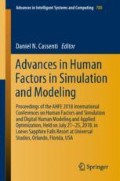Abstract
Research into the human factors of augmented reality (AR) systems goes back nearly as far as research into AR. This makes intuitive sense for an interactive system, but human factors investigations are by most estimates still relatively rare in the field. Our AR research used the human-centered design paradigm and thus was driven by human factors issues for significant portions of the development of our prototype system. As a result of early research and more recent prototype development, mobile AR is now being incorporated into military training and studied for operational uses. In this presentation, we will review human factors evaluations conducted for military applications of mobile AR systems as well as other relevant evaluations.
Access this chapter
Tax calculation will be finalised at checkout
Purchases are for personal use only
References
Sutherland, I.E.: The ultimate display. In: Proceedings of IFIP Congress (1965). Information Processing
Swan, J.E., Gabbard, J.L.: Survey of user-based experimentation in augmented reality. In: Proceedings of 1st International Conference on Virtual Reality (2005)
Dünser, A., Grasset, R., Billinghurst, M.: A survey of evaluation techniques used in augmented reality studies. In: ACM SIGGRAPH Asia Courses (2008)
Bai, Z., Blackwell, A.F.: Analytic review of usability evaluation in ISMAR. Interact. Comput. 24, 450–460 (2012)
Dey, A., Billinghurst, M., Lindeman, R.W., Swan II, J.E.: A systematic review of usability studies in augmented reality between 2005 and 2014. In: IEEE International Symposium on Mixed and Augmented Reality (ISMAR-Adjunct) (2016)
Chu, M., Matthews, J., Love, P.E.D.: Integrating mobile building information modelling and augmented reality systems: an experimental study. Autom. Constr. 85, 305–316 (2018)
Grabowski, M., Rowen, A., Rancy, J.-P.: Evaluation of wearable immersive augmented reality technology in safety-critical systems. Saf. Sci. 103, 23–32 (2018)
Azuma, R.T.: A survey of augmented reality. Presence: Teleoper. Virtual Environ. 6(4), 355–385 (1997)
Kersten-Oertel, M., Jannin, P., Collins, D.L.: The state of the art of visualization in mixed reality image-guided surgery. Comput. Med. Imaging Graph. 37(2), 98–112 (2013)
Chen, L., Day, T.W., Tang, W., John, N.W.: Recent developments and future challenges in medical mixed reality. In: Proceedings of International Symposium on Mixed and Augmented Reality (2017)
Livingston, M.A., Swan II, J.E., Julier, S.J., Baillot, Y., Brown, D., Rosenblum, L.J., Gabbard, J.L., Höllerer, T.H., Hix, D.: Evaluating system capabilities and user performance in the battlefield augmented reality system. In: Proceedings of NIST Workshop on Performance Metrics for Intelligent Systems (2004)
Zhu, Z., Branzoi, V., Sizintsev, M., Vitovich, N., Oskiper, T., Villamil, R., Chaudhry, A., Samarasekera, S., Kumar, R.: AR-weapon: live augmented reality based first-person shooting system. In: IEEE Winter Conference on Applications of Computer Vision (2015)
McKendrick, R., Parasuraman, R., Murtza, R., Formwalt, A., Baccus, W., Paczynski, M., Ayaz, H.: Into the wild: neuroergonomic differentiation of hand-held and augmented reality wearable displays during outdoor navigation with functional near infrared spectroscopy. Front. Hum. Neurosci. 10, Article 216 (2016)
Aaltonen, I., Laarni, J.: Field evaluation of a wearable multimodal soldier navigation system. Appl. Ergon. 63, 79–90 (2017)
Livingston, M.A., Dey, A., Sandor, C., Thomas, B.H.: Pursuit of ‘X-ray vision’ for augmented reality. In: Human Factors in Augmented Reality Environments. Springer, New York (2012). Chap. 4
Livingston, M.A., Brown, D.G., Julier, S.J., Schmidt, G.S.: Mobile augmented reality: applications and human factors evaluations. In: Proceedings of NATO Human Factors and Medicine Panel Workshop on Virtual Media for Military Applications (2006)
Elliott, L.R., van Erp, J.B.F., Redden, E.S., Duistermaat, M.: Field-based validation of a tactile navigation device. IEEE Trans. Haptics 3, 78–87 (2010)
Henderson, S., Feiner, S.: Exploring the benefits of augmented reality documentation for maintenance and repair. IEEE Trans. Vis. Comput. Graph. 17(10), 1355–1368 (2010)
Nielsen, J., Levy, J.: Measuring usability: preference vs. performance. Commun. ACM 37(4), 66–75 (1994)
Livingston, M.A., Gabbard, J.L., Swan II, J.E., Sibley, C.M., Barrow, J.H.: Basic perception in head-worn augmented reality displays. In: Human Factors in Augmented Reality Environments. Springer, New York (2012). Chap. 3
Squire, P., Muller, P.: Making augmented reality…a reality. Future Force, Naval Sci. Technol. Mag. 1(3), 45–49 (2014)
Gans, E., Roberts, D., Bennett M., Towles, H., Menozzi, A., Cook, J., Sherrill, T.: Augmented reality technology for day/night situational awareness for the dismounted soldier. In: Display Technologies and Applications for Defense, Security, and Avionics IX; and Head- and Helmet-Mounted Displays XX, Proceedings of SPIE, vol. 9470 (2015)
Livingston, M.A.: Issues in human factors evaluations of augmented reality systems. In: Human Factors in Augmented Reality Environments. Springer, New York (2012). Chap. 1
Acknowledgements
This research was supported by the Army Research Laboratory.
Author information
Authors and Affiliations
Corresponding author
Editor information
Editors and Affiliations
Rights and permissions
Copyright information
© 2019 Springer International Publishing AG, part of Springer Nature (outside the USA)
About this paper
Cite this paper
Livingston, M.A., Ai, Z., Decker, J.W. (2019). Human Factors for Military Applications of Head-Worn Augmented Reality Displays. In: Cassenti, D. (eds) Advances in Human Factors in Simulation and Modeling. AHFE 2018. Advances in Intelligent Systems and Computing, vol 780. Springer, Cham. https://doi.org/10.1007/978-3-319-94223-0_6
Download citation
DOI: https://doi.org/10.1007/978-3-319-94223-0_6
Published:
Publisher Name: Springer, Cham
Print ISBN: 978-3-319-94222-3
Online ISBN: 978-3-319-94223-0
eBook Packages: Intelligent Technologies and RoboticsIntelligent Technologies and Robotics (R0)

